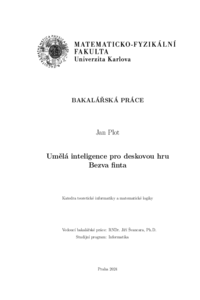Umělá inteligence pro deskovou hru Bezva finta
Artificial intelligence for board game Sneaks & Snitches
bachelor thesis (DEFENDED)

View/
Permanent link
http://hdl.handle.net/20.500.11956/193087Identifiers
Study Information System: 267805
Collections
- Kvalifikační práce [11975]
Author
Advisor
Referee
Vomlelová, Marta
Faculty / Institute
Faculty of Mathematics and Physics
Discipline
Computer Science with specialisation in Artificial Intelligence
Department
Department of Theoretical Computer Science and Mathematical Logic
Date of defense
6. 9. 2024
Publisher
Univerzita Karlova, Matematicko-fyzikální fakultaLanguage
Czech
Grade
Excellent
Keywords (Czech)
Bezva Finta|umělá inteligence|genetický algoritmus|neuronová síť|MinimaxKeywords (English)
Sneaks &, Snitches|artificial inteligence|genetic algorithm|neural network|MinimaxBezva finta je desková hra pro 2 až 5 hráčů. V jádru trochu připomíná kámen, nůžky, papír, game of chicken a prisoner's dilemma zkombinované dohromady. Cílem této práce je implementovat různé přístupy umělé inteligence jako agenty pro verzi této hry pro 4 hráče. Nejčastější přístup programů hrajících hry je prohledávání stavového prostoru například pomocí algoritmu Minimax. My ukážeme, proč tento přístup není pro naší hru vhodný. Dále vytvoříme několik jednoduchých a naivních agentů, ale využijeme i techniky evolučních algoritmů a neuronových sítí. Pomocí experimentů vybereme nejlepší genetické a neuronové agenty do závěrečného turnaje. Nakonec porovnáme všechny agenty v turnaji abychom zjistili, který z agentů je nejlepší. Součástí práce je i implementace počítačové verze této hry včetně grafického rozhraní.
Sneaks & Snitches is a board game for 2 to 5 players. At the core it somewhat resembles Rock paper scissors, Game of chicken and Prisoner's dilemma combined together. The goal of this work is to implement different AI approaches as agents for a 4 player version of this game. The most common approach of programs playing games is to search the state space using, for example, the Minimax algorithm. We will show why this approach is not suitable for our game. Next, we will create some simple and naive agents, but we will also use techniques from evolutionary algorithms and neural networks. We will perform experiments to select the best genetic and neural agents for a final tournament. Finally, we will compare all agents in a tournament to see which agent is the best. The work also includes the implementation of a computer version of this game including the graphical interface.
